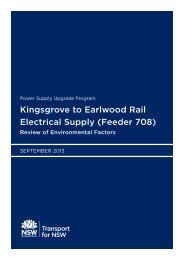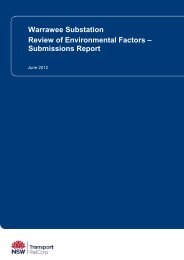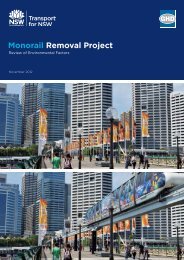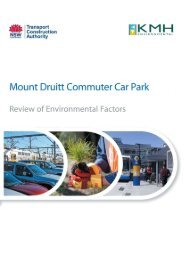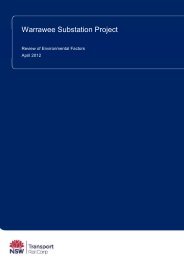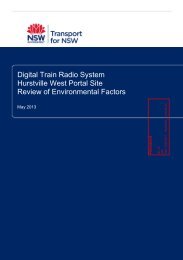Review of Environmental Factors - Transport for NSW - NSW ...
Review of Environmental Factors - Transport for NSW - NSW ...
Review of Environmental Factors - Transport for NSW - NSW ...
- No tags were found...
You also want an ePaper? Increase the reach of your titles
YUMPU automatically turns print PDFs into web optimized ePapers that Google loves.
Principal(a) A telecommunications facility must bedesigned, installed and operated so that themaximum human exposure levels toradi<strong>of</strong>requency emissions comply withRadiation Protection Standard.(b) An EME <strong>Environmental</strong> Report shall beproduced by the proponent <strong>of</strong> developmentto which the Mobile Phone Network Codeapplies in terms <strong>of</strong> design, siting <strong>of</strong> facilitiesand notifications.The Report is to be in the <strong>for</strong>mat required bythe Australian Radiation Protection NuclearSafety Agency (ARPANSA). It is to show thepredicted levels <strong>of</strong> electromagnetic energysurrounding the development comply withthe safety limits imposed by the AustralianCommunications and Media Authority andthe Electromagnetic Radiation Standard, anddemonstrate compliance with the MobilePhone Networks Code.ProposalThe proposed facility will comply with theARPANSA standard in relation to humanexposure to EME. An EME report has beencompleted and is found at Appendix 4.This report demonstrates compliance with theARPANSA standard <strong>for</strong> the operation <strong>of</strong> aradio communications facility in Australia.The proposal is not <strong>for</strong> a mobile phonenetwork and is not subject to the Code <strong>for</strong> theDevelopment <strong>of</strong> Mobile Phone NetworkInfrastructure commonly known as the ACIFCode.An EME report has been completed and isfound at Appendix 4.Principle 4: Minimise disturbance and risk, and maximise compliancePrincipal(a) The siting and height <strong>of</strong> anytelecommunications facility must comply with anyrelevant site and height requirements specifiedby the Civil Aviation Regulations 1988 and theAirports (Protection <strong>of</strong> Airspace) Regulations1996 <strong>of</strong> the Commonwealth. It must not penetrateany obstacle limitation surface shown on anyrelevant Obstacle Limitation Surface Plan thathas been prepared by the operator <strong>of</strong> anaerodrome or airport operating within 30kilometres <strong>of</strong> the proposed development andProposalThe provisions <strong>of</strong> the Civil Aviation Regulations1988 and the Airports (Protection <strong>of</strong> Airspace)Regulations 1996 were considered during thedesign and siting process. There is no need <strong>for</strong>the installation <strong>of</strong> a warning light or aircraftnavigation light, as the proposal does notpenetrate the Obstacle Limitation Surface.Page 61 <strong>of</strong> 67



